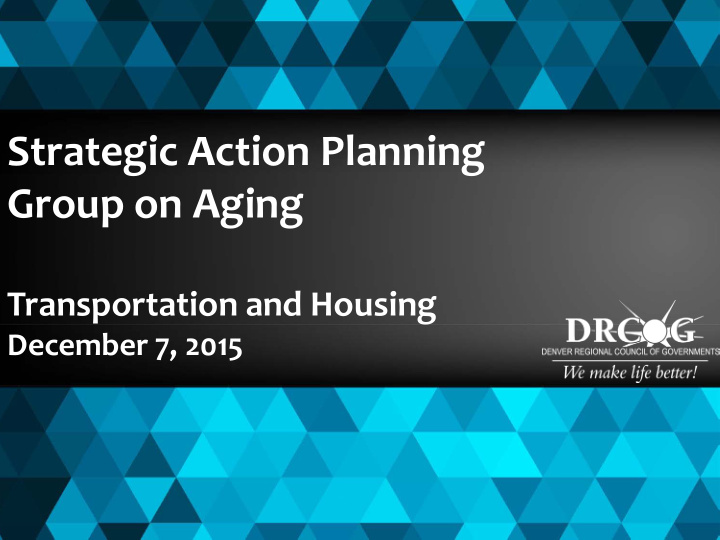



Strategic Action Planning Group on Aging Transportation and Housing December 7, 2015
Priority Service Votes 1 Transportation 298 2 In-Home Service 269 3 Home Repair/Chore Service 187 4 Nutrition Service 185 5 Information and Assistance 158 6 Caregiver Support 142 7 Material Aid 129 8 Care Management 122 9 Counseling/Mental Health 113 10 Outreach/ Public Information 107 11 Ombudsman/Elder Abuse Prevention 98 12 Health Promotion/Education 87 13 Screen and Evaluation 65
Current system is auto- dominated Nationally 21% of 65+ do not drive Limited public transportation options/cost of specialized transit Men outlive their driving years by 7 years, women by 10 Neighborhood impact on older adults Walking as physical activity
Age 50 to 74 73% 17% 8% Age 75 and older 62% 27% 9% POV Driver POV Passenger Walking All Other Modes
Schematic of Federal & State Funding Sources, Distributers, and Recipients Local Level Federal Department Federal Program State Program Distribution CDOT FASTER Transit Agencies Transit & Local FTA Transit Grants Governments CDOT Administers FTA 5310, 5311, Surface Transportation US Department of Program (STP Metro) Transportation RTD & Congestion (5307, 5309, 5337 Mitigation and Air 5339) Quality Improvement (CMAQ) alotted to DRCOG Temporary Assistance County Human for Needy Families Colorado Works Services (TANF) Area Agencies on Older Coloradans Act Aging (DRCOG, and OAA Administered Boulder, & Weld Older Americans by Aging and Adult Counties) Act (OAA) Services Department of Health & Human Services Community Developmental Developmental Disabilities Assistance & Centered Boards Disabilities Bill of Rights Medicaid Single Entry Health Care Point for Approved Medicaid Non-Medical Trips Policy & Finance Non Emergent Medical Transportation Broker (NEMT) Community Dept. of Housing & Development Communities (Based Block Grant Urban Development on Population) (CDBG) Veterans VA Health Care Administration Facilities (Note: VA Funds are also embedded in a variety of other programs such as the Work Force Investment Act. Some of these go through state programs.)
Lack of funding Gaps in service availability (geographic, service hours, frequency) Many trip requests are not fulfilled Expensive & inefficient service Paying for the trip (fixed incomes)
Coordinate Transportation Services Spend funding more efficiently Leverage multiple funding sources Coordinate trips across boundaries Implement technology that will make coordination easier Work with volunteer driver programs Remove Barriers Infrastructure improvements (sidewalks, bus stops) Provide training to ride fixed route Affordable fare programs Accessible & understandable information Increase service areas, frequency, & hours
Denver rent increases are tracking with San Francisco and San Jose New supply normally pushes down rents – new, higher-rent inventory has had the opposite effect Tightest submarkets aren’t seeing significant additional inventory (e.g. Wheat Ridge, Castle Rock, Central/NE Aurora)
Housing prices: Denver experienced the third fastest recovery from the effects of the Great Recession – outpaced by: San Jose (paced by the tech industry and global capital) Austin (fastest growing Metro area in country) Sellers on the sidelines: worry they won’t be able to afford their next home
Older adults prefer to remain in their homes and communities Lack of range of housing options in many communities Housing costs are increasing rapidly – seniors displaced every day Lack of affordable housing alternatives Two-thirds of 65+ renters spend too much on housing
• Developers are behind – attention is on Millennial-driven market • The market is not delivering needed products (something in-between SF and senior apartments) • Condos, pocket neighborhoods, etc.
Unique Development Types Senior housing with services Senior housing without services Market-rate and affordable Creative senior housing and services
• Nationally: 99% of assisted living is market-rate • Typically a suburban product – high- end/market-rate developments • Operations not real estate is the primary economic driver
• Some concern about market saturation • Attractive to institutional investors • Difficult local review process (NIMBY-ism, parking)
• Site-oriented not product-oriented (leads to competition with other uses) • More likely to utilize urban infill locations and include affordable • Profitable: Will pay premium rents
• Smaller investor market (compared to with-service or market-rate MF) • Investors not comfortable with “the idea that there will be demand and people will leave their single-family homes and pay premium rents”
• Despite demand and profitability less than 10 project have been built in recent years • Many will look to sell project after completion – unfamiliar with services needed as residents age
• Navigating the tax credit system • EXTREMELY competitive (CO: $11-12 million per year) • Most will apply in multiple rounds • Change to 1 round per year is problematic for most • Limited awards means smaller projects • Some expressed frustration of the addition of housing for the homeless to program (previously geared to low-income)
• Construction and land costs • Other products are “easier” to development – requires creativity and commitment • Permanence of age-restricted units • Zoning and parking issues can “make or break” a project • Uncertain profit • Providing services introduces additional funding gap
Strategic Action Planning Group on Aging Transportation and Housing December 7, 2015
Recommend
More recommend